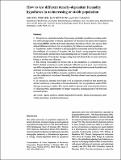Por favor, use este identificador para citar o enlazar a este item:
http://hdl.handle.net/10261/66724COMPARTIR / EXPORTAR:
 SHARE SHARE
 CORE
BASE CORE
BASE
|
|
| Visualizar otros formatos: MARC | Dublin Core | RDF | ORE | MODS | METS | DIDL | DATACITE | |

| Título: | How to test different density-dependent fecundity hypotheses in an increasing or stable population |
Autor: | Ferrer, Miguel CSIC ; Newton, I.; Casado, Eva CSIC | Fecha de publicación: | 2006 | Editor: | Blackwell Publishing | Citación: | Journal of Animal Ecology 75: 111- 117 (2006) | Resumen: | 1. We report on a simulation study of increasing and stable populations working under two different hypotheses of density dependence of fecundity: the habitat heterogeneity hypothesis (HHH) and the individual adjustment hypothesis (IAH). Our aim is to find critical differences between the two regulatory hypotheses in natural populations. 2. Populations under HHH show a strong negative relationship between fecundity and the coefficient of variation of fecundity. We also found a strong negative relationship between fecundity and skewness, demonstrating that, as fecundity decreases, the form of the distribution of brood sizes changes, being more left-skewed due to more territories failing to produce any offspring. 3. This strong relationship was found only in the simulations of populations under HHH; whether increasing or stable, and under different ratios of good : poor territories and different population sizes. In contrast, no relationship between mean fecundity and skewness was found among simulations under IAH. 4. Populations under IAH also showed a significant relationship between mean fecundity and the coefficient of variation of fecundity, but with a lower slope than in populations under HHH. 5. In conclusion, skewness was found to be an adequate critical test that showed significant and strong relationships with mean fecundity only in populations under HHH, whether increasing or stable. This test is useful for species with a discrete distribution of offspring with a small number of integer categories, including most of the bird and mammal species. © 2006 British Ecological Society. | URI: | http://hdl.handle.net/10261/66724 | DOI: | 10.1111/j.1365-2656.2005.01026.x | Identificadores: | doi: 10.1111/j.1365-2656.2005.01026.x issn: 0021-8790 |
| Aparece en las colecciones: | (EBD) Artículos |
Ficheros en este ítem:
| Fichero | Descripción | Tamaño | Formato | |
|---|---|---|---|---|
| J.Animal.pdf | 173,91 kB | Adobe PDF |  Visualizar/Abrir |
CORE Recommender
SCOPUSTM
Citations
43
checked on 17-abr-2024
WEB OF SCIENCETM
Citations
44
checked on 29-feb-2024
Page view(s)
308
checked on 18-abr-2024
Download(s)
235
checked on 18-abr-2024
Google ScholarTM
Check
Altmetric
Altmetric
NOTA: Los ítems de Digital.CSIC están protegidos por copyright, con todos los derechos reservados, a menos que se indique lo contrario.
